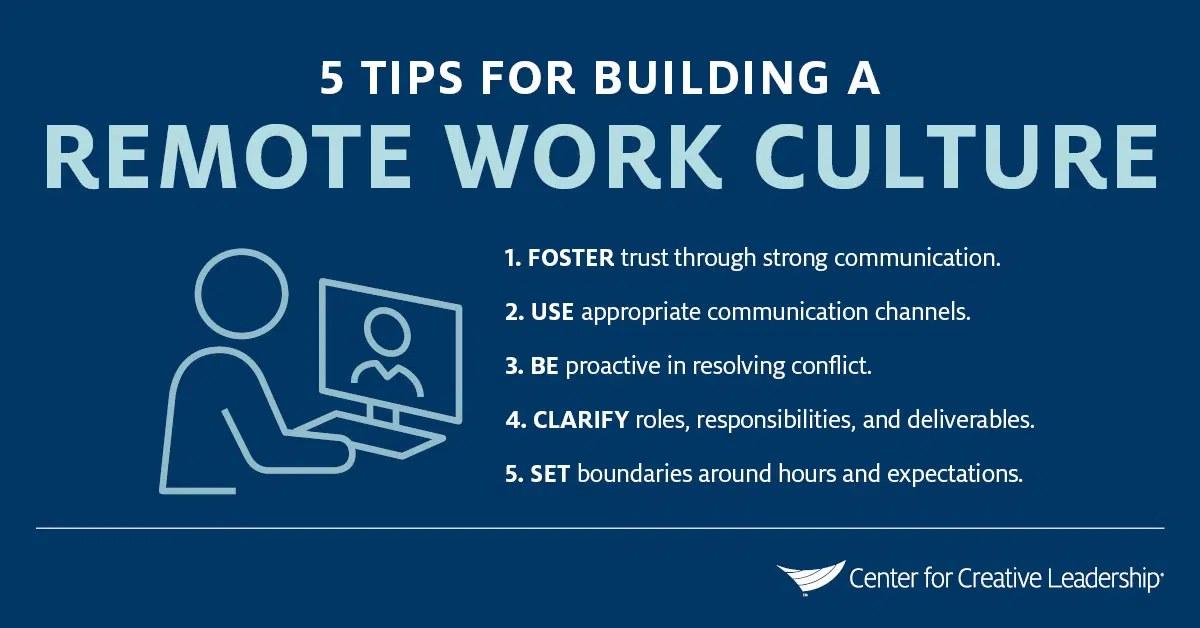Foster Your Virtual Corporate Culture With These Tips
There’s no doubt that each organization has its own culture — a self-reinforcing web of beliefs, practices, and behaviors that form that organization’s identity.
As a leader, you can know “the way we do things around here” and can sense your organization’s culture, even though it’s not always easy to define. And you know that culture impacts your employees’ personal engagement, as well as how they interact to do their jobs.
But what happens when those daily interactions are upended? In the wake of the global coronavirus pandemic and its economic aftermath, many people around the world began working from home, more so than ever before. Conference room meetings, informal hallway catch-ups, and watercooler gossip all became virtual. Employees were forced to adapt to new ways of communicating and collaborating. Then, as offices began to reopen, but only some workers came back, a new hybrid workplace reality began to set in.
And as a result, those cultural norms that were once reinforced every day when people shared physical spaces began to shift.
What Happens to Your Corporate Culture When Norms Change?
Corporate cultures are always evolving. According to Andre Keil of our coaching practice, that’s one reason why it’s hard for organizations to define their culture: “The whole thing about culture is, there’s a visible component and an invisible component. There’s the way things are supposed to get done, and the way things actually get done.”
Along the way, some behaviors get rewarded, while others get punished. “You may have certain leaders who behave in ways that are ‘against the rules,’ but if people see them continue to behave that way without getting punished, it’s likely to become normalized — and those behaviors become a part of your culture.”
In any environment, an organization’s culture shifts as its people make judgment calls about acceptable behaviors, and then adapt their behavior to establish new norms.
The pandemic and its aftermath is a great example, because it precipitated this huge shift in how we work, and because of that, new ways of conducting business have to be established. Leaders must seize this opportunity to become involved in setting norms for their new remote work culture.
“If leaders aren’t involved, people will establish their own ways of doing things,” Keil says. “At that point, you’ll have less influence.”
Building and Maintaining a Remote Work Culture
5 Tips for Leaders
1. Foster trust through strong communication.
In a virtual environment, building culture starts with building trust. When your team trusts each other, they’re more willing to work together and to align around a common purpose. Trusting relationships and candid conversations are the backbone of cultures that demonstrate open and honest communication. Put simply, better conversations yield better culture.
Yet in many cases, conversations that happen virtually may lose some important context and nuance. As a result, relationships suffer, and so does your (remote) work culture.
If you’re managing people who are working from home or located elsewhere, it’s critical you improve your virtual communications. Schedule one-on-one conversations to find out how your direct reports are doing and feeling and what’s important to them.
“As leaders, we have a tendency to want to solve problems and get into tasks and be directive,” Keil says. “But in order to build ownership with your direct reports, you have to ask them questions like, ‘How can we best work together in this environment?’ ‘How do you prefer to communicate?’ and ‘What kind of support do you need?’”
When you talk to your people, make sure you listen closely for facts, feelings, and values, advises Keil. “If you’re a leader who is generally task-focused and you suddenly find yourself managing remote employees, resist the temptation only to focus on facts when you communicate. Otherwise, you may overlook people’s feelings and values, which is what motivates them and drives their behavior.” Listening is especially powerful in the virtual space to help you learn what matters most to your team members.
During meetings, ask people to summarize what they’ve heard in order to avoid misunderstandings and to give you an opportunity to clarify points of confusion. Pause frequently for questions, and accept them with enthusiasm to create a more psychologically safe work culture where people feel comfortable speaking up.
2. Use appropriate communication channels.
As an executive coach, Keil hears a lot of frustration from leaders who feel that their days are now consumed with virtual meetings.
“Before you schedule a meeting, think about whether that’s really the best channel for communicating,” Keil advises. “There’s a lot of meeting fatigue right now, which is coming from attending video or web conferencing meetings all day long, and then not having enough time to do other tasks, which leads to overworking and burnout.”
This is a great opportunity to talk with your employees, find out their preference for communicating, and set some parameters that everyone can follow. Lay some ground rules for when an email is appropriate, versus a phone call, versus an online chat. For example, some organizations have decided that email is the appropriate platform for sharing updates, while more interactive tools like Zoom are better-suited for problem-solving. So consider which virtual collaboration tool or approach would be most helpful, and discuss with team members.
Once these guidelines become a part of your virtual corporate culture, you’ll be less inclined to make a knee-jerk decision that your team needs a video call every time you have a quick update to share. For more guidance on how to unify a remote team, check out our best practices for managing virtual teams and meetings.
Access Our Webinar!
Watch our webinar, Leading Remote Teams When the Stakes Are High, which covers the mindset, skill set, and tool set needed to effectively lead remote teams.
3. Be proactive in resolving conflict.
When a lot of change happens all at once and communication is sparse, people have a tendency to resolve their uncertainty by making up stories to explain unanswered questions.
“When you’re together in an office, some of that is alleviated because you get more hallway conversations where concerns and questions come out, leaders hear about them, and can address them,” says Keil. But when you’re working from home, there’s no natural release through traditional “watercooler” channels.
“From our research, we know that leaders tend to under-communicate,” Keil says. “Emotions left unchecked in the virtual environment might erupt into a cloud of negative comments, which will be difficult to resolve,” says Keil. “If possible, avoid sending your entire team messages dealing with conflict. Keep these conversations on an individual level.”
As a leader, a crisis is a time to step up your communications — and if you’re intentional about it, your people will follow suit, solidifying a stronger culture that feels comfortable with virtual communications.
Since you won’t run into your colleagues for hallway chats, make it a point to schedule conversations just to catch up, and be explicit about the purpose of your conversation. Even in a virtual environment where face-to-face interactions aren’t possible, leaders can signal their intent for a casual conversation.
4. Clarify roles, responsibilities, and deliverables.
One of the challenges with virtual work environments is trusting that everyone is pulling their weight when you can’t physically see them working.
“Especially in a virtual environment, your actions speak louder than your words. If you do competent work, it will show,” says Keil.
He advises that leaders focus on performance and work, and insist that colleagues communicate if they need help. “You have to be explicit about creating results, being responsive, and showing that you’re doing the work. If you’re introverted and you have it all handled but you’re not telling anybody, those story-making machines start up, and people start wondering if you’re being productive.”
To bridge the virtual distance, return calls and emails on time. Set reasonable deadlines and meet them. And if you break an agreement, renegotiate as quickly as possible.
As a leader, you can build a culture of integrity by being transparent about your role and what you intend to deliver to your teammates. Provide specific details about your tasks, and follow up on verbal agreements in writing. This is especially key if you are managing remote employees and leading from a distance.
5. Set boundaries.
“You’ve heard that fences make good neighbors,” says Keil. “If everyone is clear about their roles and responsibilities, it helps a lot and leads to more defined conversations.”
In addition to clarifying roles and responsibilities, discuss boundaries that will ensure everyone on your team feels control over their work hours.
“When many on the team are working from home, you have people who seemingly never stop working and struggle with how to define their personal life and work when it’s all in one place,” Keil says.
Talk to your teammates about expectations surrounding work hours and response times, and what “balance” looks like to them. Each of these affect personal resilience and are closely connected with how your remote work culture feels. Once those expectations are defined and respected, they can become a part of your virtual corporate culture and norms.
All of these steps can help you strengthen your organization’s collaboration and and build trust and rapport with teammates, even when you’re not working together in person and the work culture is remote.
Ready to Take the Next Step?
Your organization’s remote work culture will determine its ability to thrive in the changed post-pandemic world. Partner with us to craft a customized learning journey for your team using our research-backed modules. Available leadership topics include Collaboration & Teamwork, Conflict Management, Communication & Leadership, Listening to Understand, Psychological Safety, Virtual & Remote Team Leadership, and more.









